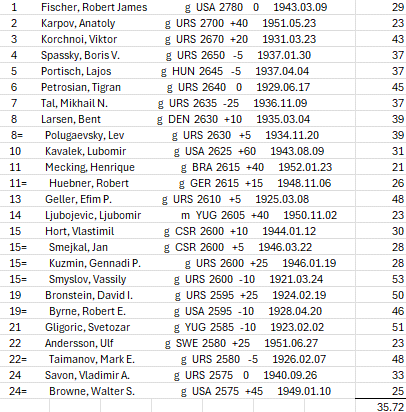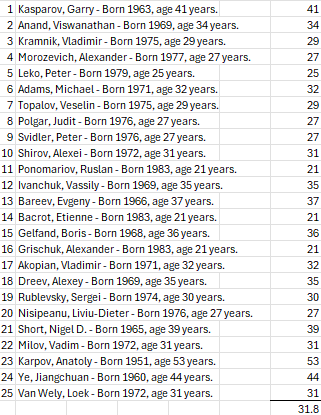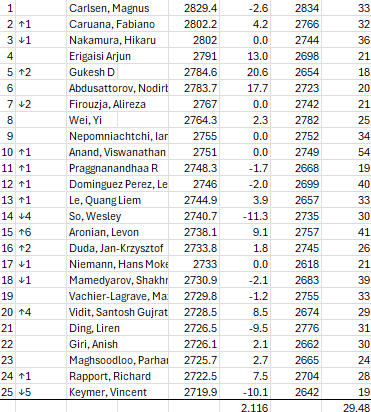I am writing this on a Friday night, travelling in the United States. By the time the post is up, I am sure the current top 25 will have moved a bit…
I was asked on Twitter if the current wave of young players was a record, so I decided to look into it a little bit.
I thought about approaching the World Ranking list in a slightly different way. Let’s presume that simple access to events is a big factor in how early someone can reach a high level. Faustino Oro has defeated Carlsen in bullet online. Kasparov played a simul game against Karpov at 12. Carlsen defeated Karpov in blitz and had a winning position against Kasparov in rapid aged 13. But in general, these are the exceptions. It is quite likely that the no 5 junior in 1974 never saw Fischer at all, let alone played with him. Development in chess requires access to high level opposition.
My other theory is that it may become easier to make the initial steps to Grandmaster, but that the level at the absolute top simply increases with every new training tool available, and while it may be useful to use engine preparation to reach GM-status, to reach the truly professional level (where the players live only by playing), requires something more, including experience.
A third thing to remember is that the Soviet players were not allowed to travel. In 2024, the wave of young players is mainly coming from India. In 1974-1994, they came from the Soviet Union. With the fall of the wall in 1989 and Perestroyka, the players were suddenly free to travel as they wished. It is hard to imagine the young careers of Kramnik and Shirov without the freedom increasing in the late 1980s. Perhaps the same can be said about Topalov and Polgar.
Caveat – I am not a statistician and these are observations, not conclusions. I understand well that if you made it top 5, top 10, top 20 or top 100, you would get different results. I chose 25, because I wanted the players under the age of 25. And no. 25 now is Vincent Keymer, one of the leaders of the young generation; who has dropped 5 places in the World Ranking due to a bad performance at the Olympiad.

Here are the six lists I have randomly chosen. 20 September 2024 and July 1st, 10, 20, 30, 40 and 50 years ago. I have ignored every reasonable objection. Fischer was inactive in 1974. Kasparov and Short banned in 1994. Anand plays 1-2 games a year.
New generations come in waves. It is both about how they compete with each other; and about the random nature of it. And random is not spread out evenly…
The average age in top 10 and top 25 now is bizarrely both 29½ years old.
Average age:
1974 35.72
1984 36.44
1994 27.52
2004 31.8
2014 31.32
2024 29.48
U25 players, highest placed and youngest in top 25
1974 2 Karpov (no. 2) – Mecking (age 21)
1984 2 Kasparov (no. 1) – Kasparov (age 21)
1994 10 Shirov (no. 2) – Polgar (age 17)
2004 3 Ponomariov (no. 11) – Ponomariov/Bacrot (age 21)
2014 7 Carlsen (no. 1) – Giri (age 20)
2024 7 Erigaisi (no. 4) – Gukesh (age 18)
Players over 40
1974 8 Korchnoi (no 3) – Gligoric (age 51)
1984 8 Portisch (no 4) – Smyslov (age 63)
1994 4 Karpov (no 1) – Karpov (age 43)
2004 3 Kasparov (no 1) – Karpov (age 53)
2014 4 Anand (no 7) – Gelfand (age 46)
2024 3 Anand (no 10 – age 54)






